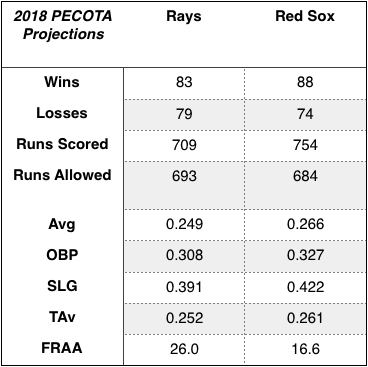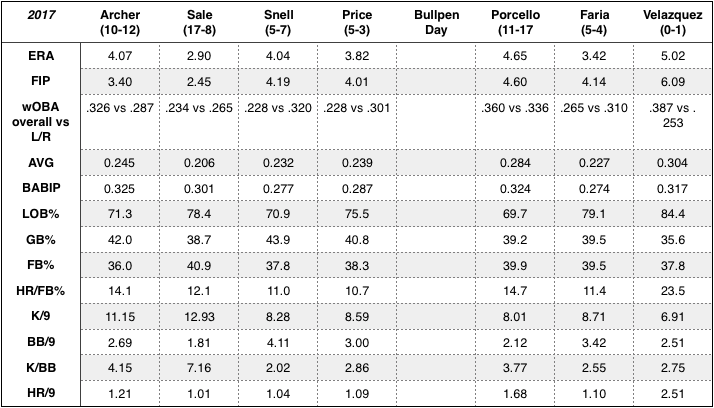
After a long winter filled with cost cutting roster moves — necessitating the addition of players unfamiliar to many casual fans of the Tampa Bay Rays — the Opening Series is finally upon us. The Rays and those Massholes will jump right into AL East division head-to-head action starting Thursday at the Trop. The Red Sox captured the division title last season before losing to the eventual World Series champion, Houston, right away, while the Rays went 80-82 to finish in third place in the East.
The Rays traded away the face of the franchise, Evan Longoria, and either traded away or let go of the top three home run producers on the team: Logan Morrison (38 homers in 2017), Steven Souza Jr. (30), and Corey Dickerson (27). However, they also each ranked among the top 10 in whiffs on four-seam fastballs. Because of it, the Rays sought out replacements that fare better against four-seam fastballs (Carlos Gomez, Denard Span and C.J. Cron). Tampa Bay’s offense is projected to improve its team-wide strikeout rate by more than 4%, best in the big leagues.
Still, in spite of all the lateral moves, the Rays neither improved the roster nor got worse. Back in February, before Black Saturday, the Rays were projected by PECOTA to go 84-78 on the season — the exact same projected W/L record as in 2017 — and PECOTA hasn’t really deviated from that projection since; +/- one win or loss.
Because the team is bereft of high powered veterans, as RJ Anderson (Baseball Prospectus) noted, a lot of things have to go right for Tampa Bay if it is going to hit the 83 or 84 high water mark projection:
I’m focusing on the postseason part more than the 83-win projection part. At minimum, Kiermaier has to stay healthy, and Snell and Faria have to be legitimate above-average starters. You can also throw in that the bullpen has to way overachieve and the lineup has to have most/all the question marks (Denard Span, Brad Miller, C.J. Cron, Wilson Ramos, Matt Duffy) avoid injury and cratering. Oh, and the kids probably have to hit the ground running, especially Adames. That we can list so many things reveals why it’s hard to take the projection seriously―it feels like there are bigger error bars here than with most teams.

Starting pitching and a lag in power let the Red Sox down in the 2017 Postseason. Boston tried to address both issues this winter, signing 30 year-old J.D. Martinez to a five-year, $110-million deal, and making a greater effort to manage Chris Sale’s offseason workload after he tired down the stretch. Sale led all of baseball with 308 strikeouts, yet finished second in the AL Cy Young Award voting after going 4-4 with a 4.09 ERA in August and September. The biggest boost to the rotation could be a full season from former Cy Young Award winner David Price, who made only 11 starts last season but came through spring training in apparent fine form.
Pitching Matchups

Chris Archer: Archer has elite strengths, thanks to his high velocity fastball/nasty slider combination. He, however, may also have a home run weakness due to his reticence to lean on a changeup he barely believes in. The 2018 projections see the excellent strikeout rate and the decent walk rate, and figure he should regress towards the league average in the home runs allowed category. Even so, Archer is still a two-pitch pitcher, and the slugging rates on his two main pitches skyrocket the third time through the order. Studies on the subject show the addition of a third pitch, especially during the later innings, can lead to a softer third time through the order penalty, and under ideal circumstances that is something the right-hander worked on during Spring Training. The known known: Archer is going to rack up the strikeouts, but also give up a fair amount of home runs the third time through the order, when he’s still mostly throwing fastballs and sliders. Archer fanned 18 in 15-1/3 innings against Red Sox last season, although he went 1-1 with a 5.87 ERA in those three starts.
Chris Sale: Last season, tweaks to Sale’s pitch mix returned a ten-point boost to his strikeout rate. The southpaw notched up his slider usage nearly eight points and sprinkled in a few more changeups, favoring his fastball in deeper counts. The result was a 43% strikeout rate and a 13.9% whiff rate on his heater, and a monstrous 36.2% strikeout rate overall. The rebound propelled Sale past the 300 strikeout total en route to a 2.90 ERA/2.45 FIP/0.97 WHIP. If not for five starts where he was tagged for 26 earned runs (over his final 11 starts) Sale would have claimed his first Cy Young Award. Key Matchups: Kevin Kiermaier (5-14, HR, 3 RBI, BB), Wilson Ramos (4-11, 2B, 2 HR, 5 RBI), Rob Refsnyder (1-3), Denard Span (3-11, 3B, RBI)
Blake Snell: A tale of two halves would be the best way to describe Snell’s 2017 campaign. The left-hander compiled a 4.85 ERA and a 1.63 WHIP in 52 first-half innings, then turned in a 3.49 ERA and 1.13 WHIP in the second half. Mechanical and placement adjustments on the rubber were catalysts that drove the positive results. Snell’s secondary offerings — slider, curveball and changeup — all have great whiff rates, with the first two sitting over 20%. His Fastball strike rate remained the same over both halves, although his BB/9 plummeted from 5.7% to 3.2%, and his whiff rate rose over 3%. If the second half of 2017 is indicitive of anything, Snell is ready to push himself up the ranks of a top-20 starter.
David Price: The former Ray was known as one of the best workhorses in the big leagues prior to 2017, notching 200+ innings in six of the past seven seasons (186-2/3 innings in 2013 with Tampa Bay being the sole exception). However, Price started last season with a mysterious arm injury, then was placed on the DL with elbow inflammation leading to the “injury prone” label which found him in the bullpen. Price returned from his malaise pumping 94.9 mph as a reliever and looking very much like the ace of old. If Price can become more consistent with his sinker, while also maintaining his fastball velocity, there is a solid chance he can return to the upper levels of the starting pitcher landscape. Key Matchups: Adeiny Hechavarria (2-7), Kevin Kiermaier (2-8, 2B, HR, RBI), Wilson Ramos (1-3)
Rays Bullpen Day
Rick Porcello: Talk about a descent into mediocrity. Pocello went from a 3.15 ERA and 1.01 WHIP Cy Young Award winning 2016 campaign, to a 4.65 ERA and 1.40 WHIP in 2017. His home run per nine innings rate ballooned to 1.68, while nearly all his pitches got launched into the outfield stands — including his vaunted sinker. As FanGraphs found, his pair of fastballs that fueled his 2016 success each saw their ISOs balloon, averaging .206 between them and allowing a combined 22 HR. Meanwhile, his changeup – a pitch known as a consistent strike-earning offering early in counts – faced a similar fate, getting slapped with a .276 ISO and 24.0% HR/FB rate. There’s reason to believe his stuff just isn’t all that great. His fastball velocity hovers around 90 mph, and he not only needs to effectively control his pitches, but also mix them well. He also needs to sprinkle in some deception to get through lineups. He may come closer to returning to his 2017 form, however, that amazing season should be viewed as the exception, not the rule. Key Matchups: CJ Cron (2-4, 2B, BB), Matt Duffy (3-10), Carlos Gomez (1-3, HR, RBI), Brad Miller (11-37, 4 2B, 5 HR, 9 RBI, 2 BB), Rob Refsnyder (1-3), Denard Span (13-35, 4 RBI, 2 BB)
Jacob Faria: The right-hander hit the ground running in his rookie campaign, boasting a stellar 2.00 ERA and 0.98 WHIP across his first seven starts. Yet despite improving his strikeout marks in the following five outings, Faria battled an abdominal injury that eventually sidelined him for a month in mid-August. While his velocity isn’t impressive, his fastball can boast some occasional cutting action that confounds hitters. Moreover, the “rising” action on the pitch plays well with his split-change and slider, which create vertical drop differentials of seven and nine inches (respectively). Per Nick Pollack (FanGraphs) Faria’s slider is his jack-of-all-trades offering that excels in any count, let it be stealing a strike early (48.3% zone rate), inducing grounders (52.2%) and pop-ups (21.1%), or earning a whiff with its sharp break (14.2%). Meanwhile, Faria’s changeup shuts the door effectively, using its 23.8% whiff rate to generate a 45.5% K rate across 244 thrown. If he can consistently command his fastball, including that cutting action, he will take the next step with the Rays.
Hector Velázquez: The scouting report on Velázquez per Over the Monster:
Velázquez offers three pitches that he trusts. His fastball isn’t overpowering, coming in at the low-90’s. He also offers a solid changeup and a splitter that’s been attributed with the reason for his 2016 breakout in Mexico. Velazquez isn’t going to overpower anyone, but at his best he throws strikes and limits free passes. That’ll play as a replacement-level pitcher, and given the lack of knowledge on him around the league he could even be better.
Noteworthiness
— Need some answered questions on Opening Day? Marc Topkin (Tampa Bay Times) has got you covered.
Like, what time do the gates open? What are the giveaways? Who is likely to be in the #Rays and #RedSox lineup? What’s new to eat and do at the Trop? And more of your questions answered https://t.co/qyeLGufoCQ
— Marc Topkin (@TBTimes_Rays) March 29, 2018
— Don’t forget to check out our season preview:
Looking Backward While Moving Forward: A Tampa Bay Rays 2018 season preview of sorts
